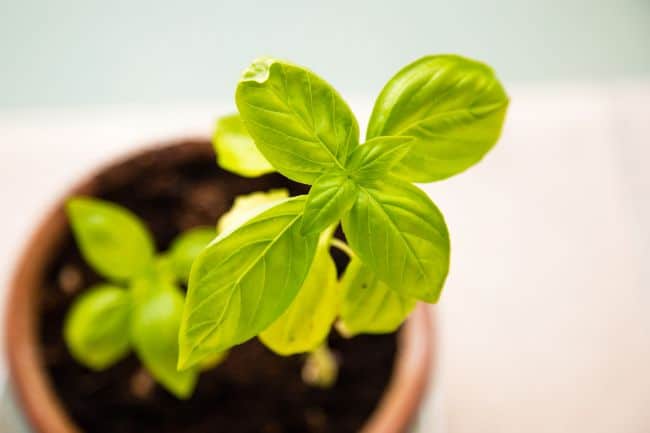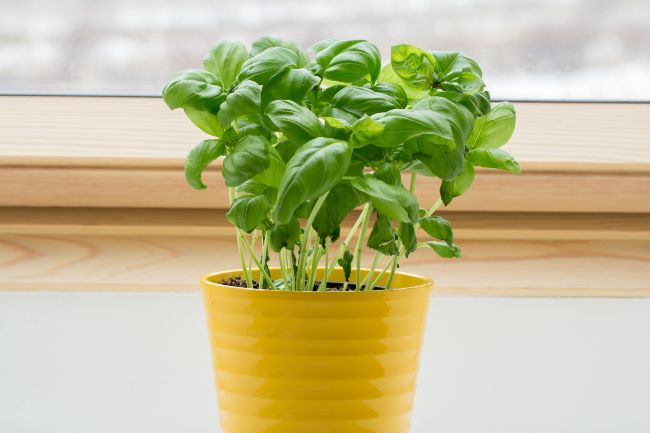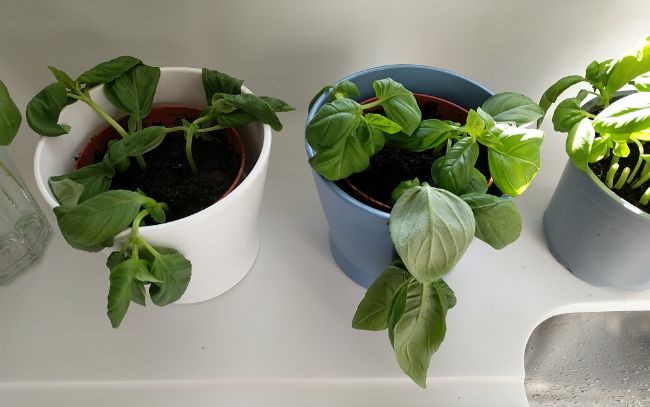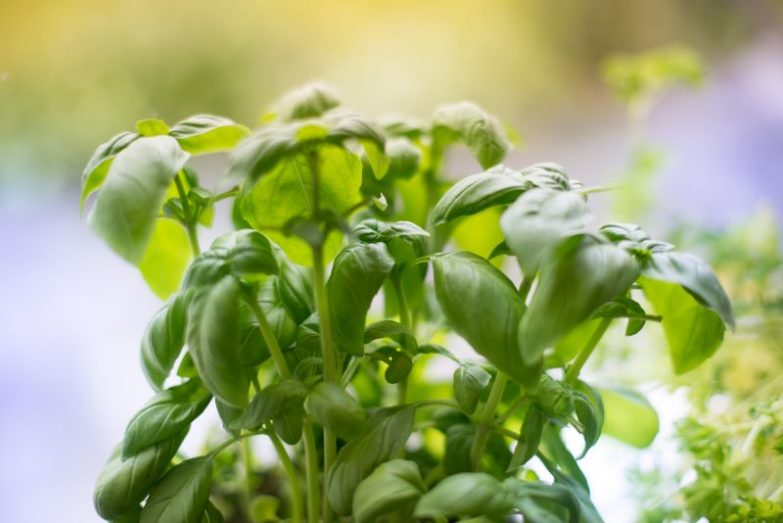Basil is an ideal herb to grow in your kitchen or herb garden, and generally they have the reputation of being easy to care for. They can be pruned and propagated regularly to provide a continuous supply of fresh basil, as long as you can keep your plants healthy. If you’re running into problems and your Basil plant is dying, this article will help you identify the cause and fix your plant.
Why is my Basil plant dying? The two most common causes of a Basil plant dying are overwatering and underwatering. Temperature stress, lighting problems, disease, or pests are also common causes of a basil plant wilting or dying. Basil plants are usually annuals, so individual plants typically only last one growing season.
This article covers each of the common reasons why your Basil plant is dying. It will explain what to look for to identify the problem and show you how to fix your Basil plant.
Watering Problems
Basil plants require consistently moist soil, but they don’t fare too well when their watering needs aren’t met. Too much water can be even more harmful than too little water. In fact, reviving an underwatered plant is normally much easier than reviving an overwatered plant.
Overwatering
Overwatering is the most common cause for your Basil plant dying. Although Basil plants like consistent access to water, their roots are poorly adapted to cope with soggy soil. In well draining soil, there are plenty of air spaces that allow air to circulate freely around the roots. In soggy soil, water fills these gaps and deprives the roots of oxygen, which is essential for their survival.
Without oxygen, the roots stop working and your Basil plant cannot get the water and nutrients it needs to survive. Very quickly, your basil plant will wilt badly and, if you don’t identify the problem quickly, your Basil plant is unlikely to survive.
Bear in mind that overwatering can happen due to more than just watering too often. Any factor that reduces root aeration or causes the soil to remain soggy will cause the same issue. Factors include;
- Planting in a pot without drainage holes, or one where the drainage holes are inadequate.
- Using soil that is poorly draining.
- Planting basil in a pot that is too large. The soil will take a long time to dry out and the roots will be deprived of oxygen for an extended period of time.
- Watering your Basil plant without checking the soil first to see if water is required.
What Does Overwatered Basil Look Like?
Overwatered Basil will initially develop paler, yellowing leaves, that often start from the lower leaves upwards. Wilting of the leaves soon follows and you may notice an offensive smell from the soil. The soil will be soggy, and if you remove the plant from the pot, the roots will be mushy and brown or black in color.

How To Fix A Basil Plant Dying Due To Overwatering
If you spot the problem early, the best thing to do is to stop watering and let the soil dry out. Make sure your plant is potted in an appropriate pot and soil. Once the soil dries out, you should resume watering, but check the plant every day or two, and only water once the surface of the soil is dry.
If your plant is wilting badly, or if the roots are smelly or mushy, then you have root rot, and the chances of the plant surviving are pretty low. You can follow this guide to identify and fix root rot, or you may be better to simply take cuttings from your plant and try to propagate new basil plants. You can read how to propagate new basil plants here.
Underwatering
This is possibly the easiest problem to fix. If you’ve forgotten to water your basil plant, and the soil is dry, your plant will be wilting badly and looking very sad. You may see crispy, brown leaves and some leaf drop, and the pot will be very light to lift.
Thankfully, they often recover very well, even when it looks like your Basil plant is dying. Water your Basil plant thoroughly to help revive it. Place it in bright, indirect light rather than in full sun and water your plant every time the surface of the soil feels dry to touch.
Once the plant has perked up and new foliage is growing, you can place your plant back in direct sunlight and resume normal care.
Avoiding underwatering can be difficult, but developing a habit for checking the water needs of your plants every day or two is a good strategy to prevent it from happening. Alternatively, you can use a self-watering pot, or even grow your Basil in a smart plant pot, to automate the care process.
Cold Damage
Basil plants aren’t cold hardy, and they will usually suffer greatly if exposed to any frost. Even temperatures below 50°F (10°C) can cause your plant stress, and lead to wilting. Lower temperatures can also increase the risk of overwatering, due to reduced plant water requirements and lower evaporation.
If your Basil plant is growing inside, you will rarely have issues with the temperature, unless your plant is placed next to a drafty window. When growing basil outside, make sure all risk of frost is gone before you sow seeds or move your plants outside.

Lighting Problems
Sometimes, lighting problems can be a cause of a basil plant dying. If you’ve picked up a Basil plant for your kitchen herb garden, it’s easy to forget the importance of providing optimal lighting for your plant.
Basil plants prefer full sun, so south- or west-facing windows are ideal. Full sun is great for most of the year but can be a little much in the heat of the summer, so watch for scorched or crispy leaves, which should be a sign to move it back from the window.
If your Basil plant is dying due to a lighting issue, low light is by far the more likely cause. Low light will cause slow, leggy growth, and new leaves will tend to be smaller or stunted.
Your Basil plant responds to lower light by arranging the chlorophyll in the leaves to catch as much light as possible. This can make the leaves appear more vibrantly green than normal, and you may think your plant is the picture of health.
However, persisting low light will soon lead to yellowing of the leaves, brown lower leaves, leaf drop, and eventually cause your basil plant to languish or die.
If you can’t provide direct sunlight for your Basil plant, then bright, indirect light is the next best thing. If you hold your hand up in an area of bright, indirect light, your hand should cast a shadow with a fuzzy border. If there is no shadow being cast at all, the light is probably insufficient for your plant.
Disease
Although there are a few troublesome diseases that can affect Basil plants, there are really only two that will result in a Basil plant dying or wilting badly.
Fusarium Wilt
Fusarium wilt is a group of soil-borne fungal diseases that affect numerous ornamental and edible plants. This fungal infection attacks the plant, blocking xylem vessels, preventing the transport of water and nutrients through the plant. Presenting symptoms including stunting of growth, wilting, yellowing leaves, fungal deposits on stems and leaves, and rotting of stems.
If your plant has fusarium wilt, the only solution is to dispose of the plant and take great care not to infect your other plants. I would advise disposing of the soil and sterilizing the pot thoroughly before growing anything else in it.
Root Rot
Root rot is a disease caused by a collection of bacteria and fungi which result in similar symptoms and have a common cause. Anaerobic conditions in the soil of your basil plant weaken the roots and allow opportunistic organisms to attack the roots of your plant.
Root rot can often be devastating, leading to your basil plant dying, but early infection can sometimes be cured. Root rot and overwatering go hand in hand, so if you spot any signs of this, check your plant thoroughly.
Repotting your plant and removing all affected roots is essential, and you should take care to water conservatively after repotting so the plant has a chance to recover.
Pests
Inside, the biggest culprits are aphids and spider mites. Outside, slugs can also be a major problem and are a common cause of a basil plant dying. Aphids and spider mites are both sap-sucking pests.
You may notice leaf spots where they have attacked the plant, and a bad infestation will lead to the plant dying of dehydration, or infection from opportunistic diseases due to the weakened plant.
Spider mites are very tiny and can multiply rapidly. Look for wisp-like webs between the foliage and look very closely on both sides of the leaves to spot the bugs. Aphids are larger and should be easily spotted.
There are numerous treatments that can control your bug infestation. I’ve written an article about identifying and treating common houseplant bugs that you may find useful.

Why Is The Stem Of My Basil Plant Turning Brown?
Brown stems can be a sign of bacterial or fungal diseases. If the stem feels wet or mushy, then your plant has a major problem and you should take rapid action to save your plant.
If your basil plant is otherwise healthy, browning of the stem may be a sign of it becoming woody. A woody stem will be firm and less flexible than younger stems. Older Basil plants will commonly develop woody lower stems.
How Do I Revive My Basil Plant?
The solution depends on the cause of your Basil plant dying. Before you try to revive your plant, you must examine your plant and the growing conditions closely.
A Basil plant drooping due to underwatering will usually recover quickly once you start watering properly, but it can be harder to revive your plant from some other causes.
How Long Will Basil Live?
Most types of Basil plant, including those most commonly grown at home, are annuals, and only live for one growing season. Basil plants typically live for between 6-9 months. So if your basil plant is dying, bear in mind that it may just be the end of its normal life.
How To Fix A Dying Basil Plant By Propagating New Plants
The great thing about growing Basil is that it is so easy to propagate. There’s no need to worry about your Basil dying when you can just take a few cuttings and propagate them in soil or water. Read this article for instructions on how to propagate Basil.
The leaves of young Basil plants tend to have the best flavor, so it is a good idea to propagate your Basil plant every few months so you always have a frresh supply of Basil on your windowsill.

